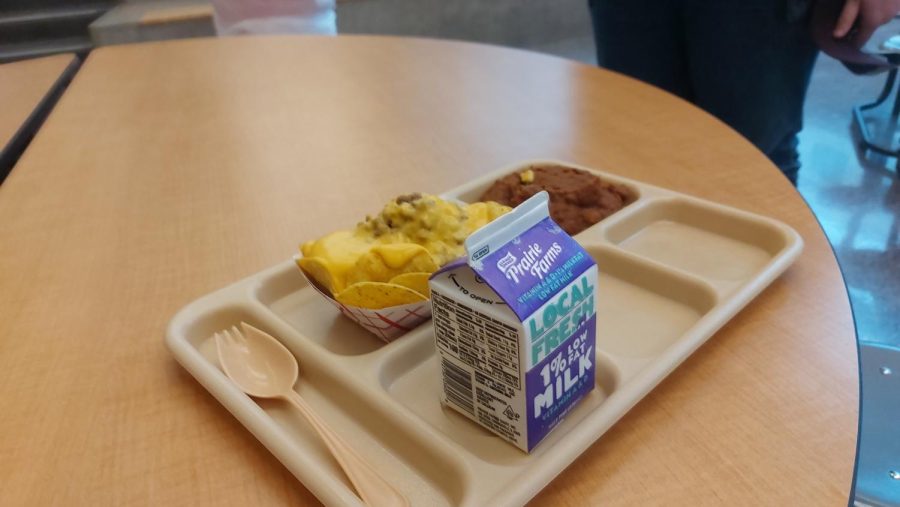NCHS students want fresher food and more choices for school lunches
While Natrona County School District chooses lunch items based on cost, students want fresher food. Is there a way for both?
This student’s lunch tray of nachos, refried beans, and milk doesn’t contain any fresh vegetables or fruit. While some fruits and vegetables are offered, many of the ingredients for NCHS school lunches are processed or contain additives. Students say that they would like to see changes to school lunch. Ben Clark, a freshman, says that they could be improved by “making them more fresh.” Clark finished by saying that he would be interested in seeing more local and organic and sustainable food options available in the cafeteria.
April 28, 2022
Natrona County School District (NCSD) has an important job, and with it a lot of responsibility. From managing transportation to funding the music programs, NCSD works hard to meet the needs of staff and students. However, though they do a great job, there is still room for improvement. Many NCHS students would like improvements to the school lunch program.
I’ve always brought a sack lunch because of my food allergies and dietary restrictions. However, the lack of unprocessed food made eating school lunch an impossible option, even if it didn’t contain the foods I was allergic to. I decided to look into the school lunch system to find out how it works and why the food options were so limited. It is my hope in writing this article that I can amplify the voices of those students who would like to see improvements to the school lunch program in NCSD.
I started by looking at health reports on Wyoming. Though Wyoming has one of the lowest childhood obesity rates in the nation according to the “State of Childhood Obesity” report by the Robert Wood Johnson Foundation, the study has a surprising lack of data on high school students in Wyoming. I then contacted Desiree McAdams, the Director of Food Services and Warehouse for the Natrona County School District. I emailed McAdams some questions regarding the planning of meals and purchasing contracts. McAdams outlined the process that NCSD uses to award purchasing contracts to companies for school lunches. McAdams said “NCSD sends our Request for Proposals and Formal Bids to all potential vendors. The Request for Proposal is awarded based on a point system. This way the District can consider things such as a vendor’s ability to get the items we requested in a timely manner. However, price must be a contributing factor.” McAdams follows by saying that “A Formal Bid is awarded based solely on cost.”
Meal planning is partially decided by the school district’s budget. McAdams said “NCSD Food Services is a self-sustaining program. We work to keep all costs, including food cost, labor, and operating expenses at what we receive from meal sales and government reimbursement. This efficiency allows us to serve nutritious meals at a reasonable price for students…NCSD utilizes an inclusive budget process for the district’s budget. Working together with the schools, the NCSD Director of Business Services identifies the needed budget for each school.”
Though no school district has an unlimited budget for school lunches, picking the cheapest vendor, without more consideration for the quality of food, isn’t the healthiest choice for students. In a study of California schools conducted by the National Bureau of Economic Research, researchers found that “Students at schools that contract with a healthy school lunch vendor score higher on CA state achievement tests.” They also found that “[there was a] larger test score increase for students who are eligible for reduced price or free school lunches.”
Next, I interviewed students about the quality of school lunches at NCHS and what changes they would like to see in the future. NCHS students said that they would like to see more fruits and vegetables, as well as less processed food, appear in the cafeteria. Some students would also like to see more variety in the food served.
Olivia Devoe, an NC freshman, says, “I personally don’t like them, so I bring my own lunch to school everyday.” She says that the district should “Make [the school lunch] more not processed, make them more fresh.” Other students also share this sentiment.
Another freshman, Ben Clark, says that school lunches “are kinda mediocre, they could be better.” He also adds that the school lunches could be improved by “making them more fresh.” Clark finished by saying that he would be interested in seeing more local and organic and sustainable food options available in the cafeteria.
Some students would also like to see more variety in the food served.
Ishuai Bond, an NCHS Senior says he leaves for lunch because he thinks it’s better to eat what he wants rather than what the school provides. He says that the school district could improve lunches by increasing the diversity of food offered, “like, give us more choices other than pizza and the regular stuff. Like the carrots and the milk. Nobody usually eats it. The corn.” Bond reiterates his point by saying “give us more choices, like yogurt or something.”
Though it may seem like students simply don’t like pizza, carrots, corn or milk, this may not be the case. It may be the quality of the food, not the vegetables themselves that has led to their use as projectiles rather than their consumption. At least some of the vegetables served for lunch at NCHS are canned, while others, as students mention, are not the freshest.
During the interview, I also asked how meals are planned to meet USDA guidelines. McAdams said “Meals are planned using Nutrikids software. This software ensures that we are compliant with all USDA guidelines. The meals are planned by the Food Services Director and the Administrative Specialist in the Food Services Department. The foods we serve are chosen based on availability from our supplier, cost, and popularity among students.”
I visited the Nutrikids (the meal planning software) site, which is managed by Heartland School Solutions, to get more information. It has several free resources to help schools plan meals with variety and seasonal or local ingredients, as well as resources to help train cafeteria staff. Some of these resources also focus on incorporating more meals made from scratch (less processed) into students’ diets through the school lunch program.
Though the cafeteria food may look delicious, there are actually some concerning additives hiding in the ingredient list. For example, the ingredients for chicken gravy include not only chicken fat, but also carmel color and disodium inosinate, a flavor enhancer found to cause high mortality rates in fire ants and fruit flies, which raises concerns about its effects on humans. Another example of an interesting ingredient list? The “mashed potatoes” contain artificial colors and flavors.
Though students would like to see a movement towards fresher and less processed lunches, it may not happen next year. McAdams said, “There will be some changes to lunches next year. These changes will be based on ongoing supply chain issues.” If a student has food allergies, “The district will work with any student who has allergies to ensure they can receive a meal without the allergens they are allergic to, with documentation submitted to the school,” McAdams says. “At this time, there has not been discussion or direction to move towards local/unprocessed foods [for school lunches].”

